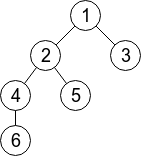Codeforces Round #405 Div. 1 B. Bear and Tree Jumps
来源:互联网 发布:vscode 设置语法高亮 编辑:程序博客网 时间:2024/05/18 00:59
A tree is an undirected connected graph without cycles. The distance between two vertices is the number of edges in a simple path between them.
Limak is a little polar bear. He lives in a tree that consists of n vertices, numbered 1 through n.
Limak recently learned how to jump. He can jump from a vertex to any vertex within distance at most k.
For a pair of vertices (s, t) we define f(s, t) as the minimum number of jumps Limak needs to get from s to t. Your task is to find the sum of f(s, t) over all pairs of vertices (s, t) such that s < t.
The first line of the input contains two integers n and k (2 ≤ n ≤ 200 000, 1 ≤ k ≤ 5) — the number of vertices in the tree and the maximum allowed jump distance respectively.
The next n - 1 lines describe edges in the tree. The i-th of those lines contains two integers ai and bi (1 ≤ ai, bi ≤ n) — the indices on vertices connected with i-th edge.
It's guaranteed that the given edges form a tree.
Print one integer, denoting the sum of f(s, t) over all pairs of vertices (s, t) such that s < t.
6 21 21 32 42 54 6
20
13 31 23 24 25 23 610 66 76 135 85 99 1111 12
114
3 52 13 1
3
In the first sample, the given tree has 6 vertices and it's displayed on the drawing below. Limak can jump to any vertex within distance at most 2. For example, from the vertex 5 he can jump to any of vertices: 1, 2 and 4 (well, he can also jump to the vertex 5 itself).

There are  pairs of vertices (s, t) such that s < t. For 5 of those pairs Limak would need two jumps:(1, 6), (3, 4), (3, 5), (3, 6), (5, 6). For other 10 pairs one jump is enough. So, the answer is 5·2 + 10·1 = 20.
pairs of vertices (s, t) such that s < t. For 5 of those pairs Limak would need two jumps:(1, 6), (3, 4), (3, 5), (3, 6), (5, 6). For other 10 pairs one jump is enough. So, the answer is 5·2 + 10·1 = 20.
In the third sample, Limak can jump between every two vertices directly. There are 3 pairs of vertices (s < t), so the answer is 3·1 = 3.
分析:一棵子树的所有路径可以分为过根和不过根节点,这题特殊在一步可以走k(k <= 5)条边,所以我们把所有路径按照模k划分为k类然后每次dfs时讨论一下就可以了,复杂度O(n*k^2).
#include <bits/stdc++.h>#define MOD 10000007#define N 200005using namespace std;int n,k,u,v;long long ans,tf[5],tg[5],f[N][5],g[N][5];vector<int> G[N];void dfs(int u,int fa){g[u][0]++;for(int i = 0;i < G[u].size();i++){int v = G[u][i];if(v != fa) {dfs(v,u); for(int j = 0;j < k;j++){tf[(j+1) % k] = f[v][j] + ((j+1)/k)*g[v][j];tg[(j+1) % k] = g[v][j]; }for(int j = 0;j < k;j++) for(int j2 = 0;j2 < k;j2++) ans += tf[j]*g[u][j2]+tg[j]*f[u][j2]+((bool)((j+j2)%k) + (j+j2)/k)*g[u][j2]*tg[j]; for(int j = 0;j < k;j++) {f[u][j] += tf[j];g[u][j] += tg[j];}}}}int main(){scanf("%d%d",&n,&k);for(int i = 1;i < n;i++){scanf("%d%d",&u,&v);G[u].push_back(v);G[v].push_back(u);}dfs(1,1);cout<<ans<<endl;}- Codeforces Round #405 Div. 1 B. Bear and Tree Jumps
- Codeforces Round #405 D. Bear and Tree Jumps 树形DP
- codeforces 405 D. Bear and Tree Jumps 树形dp
- codeforces D. Bear and Tree Jumps
- codeforces 791D Bear and Tree Jumps
- Codeforces Round #405 Div. 1 Bear and Company(DP)
- codeforces 711C. Bear and Tree Jumps(树上距离)
- Codeforces 791D Bear And Tree Jumps 树形DP
- CF791D-Bear and Tree Jumps
- Codeforces Round #226 (Div. 2) B. Bear and Strings
- Codeforces Round #226 (Div. 2)B. Bear and Strings
- Codeforces Round #226 (Div. 2)B. Bear and Strings
- Codeforces Round #356 (Div. 2) B Bear and Finding Criminals
- Codeforces Round #318 [RussianCodeCup Thanks-Round] (Div. 1) B. Bear and Blocks dp
- Codeforces Round #263 (Div.1) B. Appleman and Tree
- Codeforces Round #263 (Div. 1) B. Appleman and Tree
- Codeforces Round #263 (Div. 1 - B) Appleman and Tree
- Codeforces Round #263 (Div. 1) B. Appleman and Tree
- leetcode217 Contains Duplicate java
- 前端性能优化
- 关于activiti
- 交叉编译器 arm-linux-gnueabi 和 arm-linux-gnueabihf 的区别
- nagios_监控客服端口
- Codeforces Round #405 Div. 1 B. Bear and Tree Jumps
- 关于Mysql中select into outfile权限的探讨
- AndroidStudio真机运行后中文乱码
- [Linux/Ubuntu] vi/vim 使用方法讲解
- SQL 函数
- 水果分类
- Java并发编程
- 中心极限定理的一个例子:大小医院的新生儿
- Gallery、ImageSwitcher


